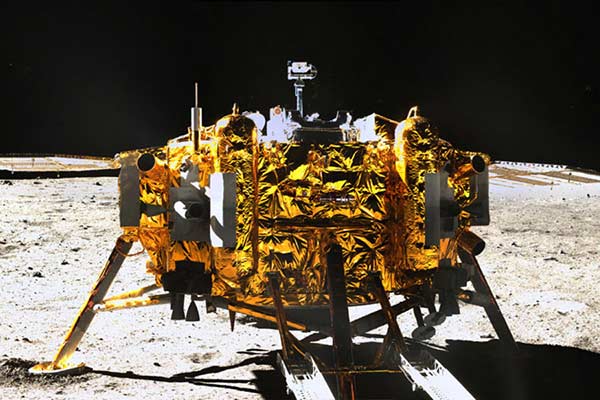 |
|
Released image of Chang'e-3 on lunar surface. [Photo/Xinhua] |
BEIJING - Chang'e-3, China's first lunar lander, has been operating on the moon for over two years, the longest time for an active probe, according to a Chinese scientist.
The probe has exceeded its operational life of one year and has been in service for 15 extra months since landing on the moon on Dec 14, 2013.
"It seems that Chang'e-3 will continue to keep working," said Ye Peijian, chief scientist with the Chang'e-3 program.
The State Administration for Science, Technology and Industry for National Defense (SASTIND) announced on Feb. 18 that Chang'e-3 had woken automatically after hibernating for the lunar night, and had entered its 28th lunar day.
Its astronomical telescope and other surveying devices are still working well, SASTIND said.
Lunar rover Yutu, which hitched a ride with Chang'e-3, was designed to operate for six months.
"Now, because of a mechanical control abnormality, Yutu is immobile. The defect also affected the solar panels that cover the rover during the lunar night to protect it from the harsh temperatures. Despite the panels not working, Yutu still continues to collect and sent data to Earth thanks to its innovative temperature control system," said Ye.
China has shared the data collected by Chang'e-3 probe with the world, helping scientists understand more about the moon and space, Ye said.
China to use data relay satellite to explore dark side of moon
China will launch a data relay satellite to ensure communication between Earth and the lunar probe during an expedition to the far side of the moon, Ye Peijian, chief scientist with China's lunar exploration program, said Tuesday.
China in January announced plans to send the Chang'e-4 probe to the dark side of the moon around 2018. Due to gravitational forces, this part of the moon is not visible to Earth and has never been explored by humans. The data relay satellite will be launched six months before the probe.
Earth can contact Chang'e-4 with the help of a "communication station" on the Lagrange point L2 of the Earth-moon system, 80,000 kilometers away from the moon, according to Ye.
"The moon is too small to block the signal transmission between Earth and the data relay satellite," said Ye.
Chang'e-1 mission in 2007 began the era of China's lunar exploration, the launch of the Chang'e-2 and Chang'e-3 followed soon after. The latter marked completion of the second phase of China's lunar program, which includes orbiting, landing and returning to Earth.
Chang'e-3 delivered a rover and stationary lander to the moon in 2013, making China the third country after the Soviet Union and the United States to carry out such a mission.
China is preparing for its next lunar probe mission, Chang'e-5, which is expected to be launched around 2017.
The probe will be tasked with landing on the moon, collecting samples and returning to Earth.
